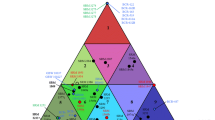Summary
The analytical quality control program employed by the ongoing FAO study on 14 trace elements in nationally representative staple foods of European countries is presented. The analytical quality control used is based on: 1) precautions taken to avoid trace element contaminations or losses during sampling and sample handling; and, 2) on methods used to guarantee that the actual determinations yield correct results. The precautions are presented. A number of certified biological reference materials (RMs) were used to validate the analytical methods employed. The following staple food RMs were also prepared: wheat flour, potato powder, animal muscle (pork) and milk powder. They were tested for homogeneity and subjected to an interlaboratory comparison study on the basis of which recommended values for trace element concentrations were defined. Further, the mean relative standard deviation for the 95% confidence limits of the medians in all RMs was below 5% for Ca, Mg and Zn; below 10% for Mn; below 15% for Fe, Cu and Se; and below 25% for Mo and Ni. These RMs were used to control the analytical quality of the trace element determinations in the actual samples. It is concluded that important contaminations were avoided in sampling and sample handling and that use of the RMs described was necessary to guarantee the analytical quality of the results.
Similar content being viewed by others
References
Analytical methods for atomic absorption spectrophotometry. Revised in January 1982. Perkin-Elmer, Norwalk, CT, USA
Koirtyohann SR, Kaiser ML, Hinderberger EJ (1982) J Assoc Off Anal Chem 65:999–1004
Kumpulainen J, Wolf W, Veillon C, Mertz W (1979) J Agric Food Chem 27:490–494
Kumpulainen J, Raittila AM, Lehto J, Koivistoinen P (1983) J Assoc Off Anal Chem 66:1129–1135
Paakki M, Kumpulainen J (1985) 10th Nordic atomic spectroscopy and trace element conference, Turku, Finland August 6–9, 1985 Book of Abstracts p 46
Parr R (1986) Intercomparison of trace and minor elements in IAEA mixed human diet (H-9). Progress Report No. 1. January 30, 1986 IAEA, Vienna
Pszonicki L (1985) Anal China Acta 176:213–227
Report of the international analytical group for the chemical study of feeds (Kadijk F, ed.) Bedrifslaboratorium voor Gronden Gewasonderzaek, Mariendaal-Oosterbeek, Holland 1984
Report of the 1983 consultation on the European cooperative network on trace elements, Aarhus, Denmark May 13–June 3, 1983. Report M/Q3861/E 8-83/1/350 FAO, Rome
Report of the 1985 consultation on the European cooperative network on trace elements, Murat-Le-Quaire, France September 17–20, 1985. Report M/R 6562/E/1-86/1/900 FAO, Rome
Sillanpää M (1975) Proposals for establishing scientific cooperation within networks on trace elements studies. Report W/H8625, FAO, Rome
Author information
Authors and Affiliations
Rights and permissions
About this article
Cite this article
Kumpulainen, J., Paakki, M. Analytical quality control program used by the trace elements in foods and diets sub-network of the FAO European cooperative network on trace elements. Z. Anal. Chem. 326, 684–689 (1987). https://doi.org/10.1007/BF00473530
Received:
Issue Date:
DOI: https://doi.org/10.1007/BF00473530




